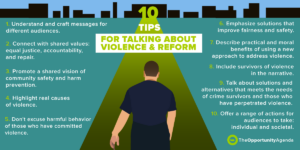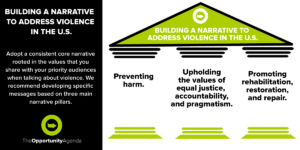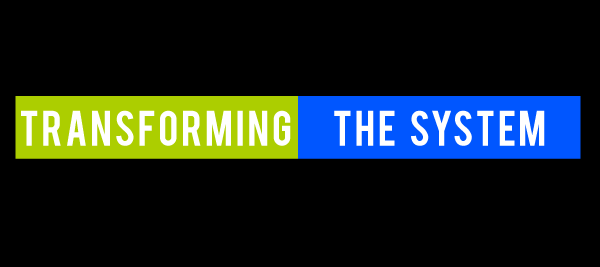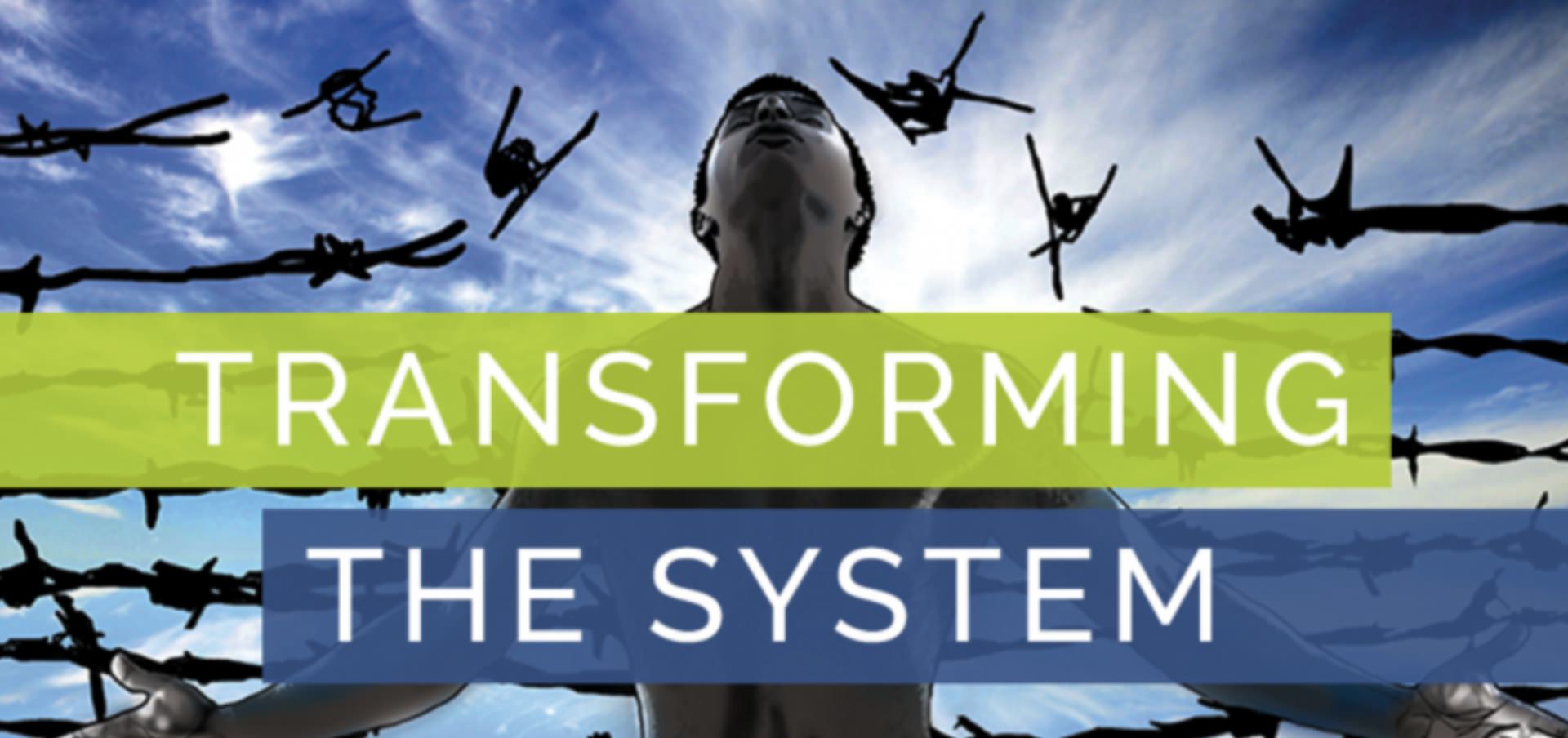Building a Narrative to Address Violence in the U.S.
This memo holds guidance for engaging strategic audiences in conversations about how to address violence and those who have been accused of or convicted of violence in the U.S. The recommendations here emerge from a thought partnership between The Opportunity Agenda, which has extensive expertise in communications and messaging, and Common Justice, which has a decade of experience working on and talking about violence and repair.
This advice is intended to help shape a larger story, or narrative, around violence, its causes, and the people involved and change hearts, minds, and policies around the issue.
These ideas are meant to serve as a jumping off point for more specific messages. The idea behind relying on common, or “big ideas” in talking about violence issues is to develop a familiar, pro-reform story that moves our target audiences. A compelling and coherent “echo chamber” helps to unite diverse voices and viewpoints, and helps to move audiences toward positive policy changes.

Narrative Principles
We recommend adopting a consistent core narrative rooted in the values that you share with your priority audiences and the themes that you want to communicate again and again in different forms and situations. You can then develop specific messages—whether for a press conference, a TV soundbite, a speech, town hall, or tweet—based on those core principles.
For reasons discussed more fully below, we recommend a narrative rooted in three main pillars:
- Preventing harm,
- Upholding the values of accountability, equal justice, and pragmatism, and
- Promoting rehabilitation, restoration, and repair.
Other relevant values include safety, opportunity, and community. These core themes can be adapted to promote the large majority of your goals, and to respond to a wide range of events and challenges.
Working from that foundation, a Core Narrative should:
- Lead with shared values.
- Highlight the systemic obstacles to those values that communities face.
- Promote effective solutions, successes, and alternatives.
While virtually all communications should flow from the same core narrative, your specific messages should be customized for different audiences, spokespeople, issues, and contexts. The following principles can help to produce messages that are genuine, accurate, and strategic.
Engage Strategic Audiences
Key to developing and implementing a narrative that encourages commonsense criminal justice reform focused on prevention and fairness is engaging strategically with different audiences. We recommend considering priority audiences in terms of:
- Persuading undecided audiences. Most people fall into this group, either because they are carrying competing narratives in their heads or simply haven’t thought very much about the issue. Nationally, for instance, Millennials, independent voters, and people of faith are disproportionately open and persuadable on criminal justice issues.
- Activating the base. People who support reform but are not yet fully engaged in promoting or implementing it should be prioritized for organizing and calls to action. They can also be called upon to convince people in their networks who are not yet on board with reform.
- Engaging those most affected. Survivors of crime are an important voice for reform and should be respectfully engaged. Public opinion research suggests that survivors of crime are increasingly disappointed by their treatment within the criminal justice system,[1]and many favor accountability through restorative justice, community supervision, or drug and mental health treatment instead of prosecution and incarceration.
Build a Strategic Message
One formula for building an effective message is Value, Problem, Solution, Action. Using this structure, we lead with the shared values that are at stake, outline why the problem we’re spotlighting is a threat to those values, point toward a solution, and ask our audience to take a concrete action.
Lead with values and vision. Most communicators agree: people don’t change their minds based on facts alone, but rather based on how those facts are framed to fit their emotions and values. Shared values help audiences “hear” messages more effectively than do dry facts or emotional rhetoric.
- A central goal of any community is the safety of its members.
Introduce the problem. Frame problems as a threat to your vision and values. This is the place to pull out stories and statistics that are likely to resonate with the target audience.
- Currently, our prison system only exacerbates harm in communities by isolating people, separating families, and providing little or no rehabilitation. This doesn’t serve the needs of survivors, communities, or those who are imprisoned. That doesn’t make our communities safer.
Pivot quickly to solutions. Positive solutions leave people with choices, ideas, and motivation. Assign responsibility—who can enact this solution?
- We need to take a close look at what really reduces violence in our communities, and how communities heal from its aftermath. We know that when survivors of violence, for instance, are involved in decisions about how we hold people who have engaged in violence accountable, some remarkable things happen that are much more in line with our goals and values than the mass imprisonment we’re seeing now.
Assign an action. Try to give people something concrete that they can picture themselves doing: making a phone call, sending an email. Steer clear of vague “learn more” messages when possible. Ask your audience to take action on your behalf, by sharing the information about your office with friends and family members, attending community events, and/or visiting your website.
- Join us by [include a concrete action that your audience can take].
Sample Messages
Accountability, Restoration, and Repair
When people hurt others, they have to be accountable for the damage they cause. Then we have to make sure our response makes that violence less likely in the future. All too often, people equate punishment and accountability, even though the two are not the same. The result in the United States has been a globally unique and historically unprecedented level of punishment and a gaping lack of meaningful accountability among people who commit harm[2]. People grow and change over time in response to their circumstances, and those who commit crimes, including violence, can earn the chance for reconciliation, rehabilitation, and a new start by taking responsibility for their choices. This includes providing the conditions that allow people to develop, to rebuild, and to take full responsibility for their lives after serious and damaging mistakes. Our current outdated system instead favors locking people up with no opportunity — or really even expectation — for change.
We need effective approaches to holding people accountable for violence that are appropriate and proportionate to a person’s conduct and circumstances. And we must recognize that while responsibility is an often-rocky road that requires patience and compassion as well as swift and steady intervention, it is the most effective long-term solution to meet our goals of safety and healing.
Safe and Healthy Communities
We are committed to adopting policies and practices that enhance community safety and build healthy and safe communities.
There are real challenges in improving community safety in [City/County], and it’s important to adopt policies that are commonsense and focus on addressing cycles of violence and prevention.
A safe community is one where there is mutual respect, trust, and an understanding of and a looking out for each other. When people fear going to the police to report a crime, it makes us all less safe. We need policies that increase collaboration and make all community members safe.
Preventing Harm
Everyone wants to feel safe in their communities and feel comfortable talking to their neighbors, local police, and government officials.
Community safety is not just about crime and incarceration rates. We should be working toward a vision of community safety that is holistic and different from outdated models of measuring safety.
Pragmatism
We need to take a responsible approach when it comes to addressing and preventing violence in our communities. We need to implement policies that are both effective and practical.
This means taking a look at what our real goals are and should be around violence and violence prevention, looking at new ideas that will move us all forward, and relying on the knowledge and experience of survivors of violence to guide our policies.
Preventing Harm
We all want to live in safe and strong communities where we look out for each other. But currently, disruptive criminal justice practices often do more harm than good, neither preventing nor addressing violence. Instead, too often survivors of crime feel caught up in an ineffective system, and those who have committed violence are imprisoned for long periods of time without truly making amends for their actions.
There is a better way. We can craft policies that address survivor and community needs that hold people who commit violence accountable, while also making it possible for them to rejoin and contribute to the community once again.

Additional Messaging Recommendations
Put forth a shared vision. Audiences connect with messages that reflect their values and articulate a better world. Outline a transformative vision of what the country could look like with sensible policies to prevent and address violence and to work with those affected by it. We need attitudes and policies that create:
- A country where fewer people are harmed by violence and fewer people are imprisoned.
- A country where people who are harmed get what they need and deserve when they have been hurt.
- A country that understands that healing and prevention are more effective strategies for keeping communities safe than high incarceration levels.
- A country that knows that because most people are capable of change, we are better off by focusing on that capacity rather than punishment.
Remind audiences about shared values. The goal of our criminal justice system should be to keep all communities safe, prevent harm, and uphold the values of fairness and equal justice. Remind people that to meet those goals, we have to align our policies with our values:
- Accountability: Those who have committed violent crimes must make amends. Our policy makers and the criminal justice system must be accountable to communities and to people who have been affected.
- Equal Justice: Emphasize this core value for us as Americans, which focuses on being treated equally by the system and guarding against anyone suffering from unfair disadvantages.
- Community Safety: We need to make sure our policies truly are about keeping all communities safe.
- Prevention: Describe the real causes of violence and the real solutions to preventing it. Emphasize prevention as a real way to keep communities safe.
- Dignity: is about our inherent value and sense of respect.
Emphasize innovation and new ideas. Survivors, in particular, are widely supportive of prioritizing prevention, alternatives to incarceration and treatment programs, and case-by-case sentencing, particularly when they think those will advance safety. They are weary of the effectiveness of judges and parole boards in making those determinations (due in large part to many survivors’ own experiences with prejudice and recognition of the history of unfair treatment faced by communities of color, particularly black Americans). Despite this distrust in system actors, many survivors of violent crime are open to new ideas and recognize that incarceration does not necessarily lead to a safer society.
Highlight the need for systemic solutions for systemic problems. While news reports mention individual crimes, they do not talk about the systemic causes of crimes in the community. Few stories explain root causes in any detail, and forces behind the disparate impact of crime based on race, ethnicity, and gender are rarely explored. Take the opportunity to connect an inadequate health care? system, lack of social safety nets, and poverty, while offering solutions that prevent violence by investing in community opportunity and wellbeing.
Show the connections. The idea that we are interconnected and all in this together is crucial to the success of reform-oriented communications. Americans intuitively understand that increasing inequality and poverty hold back the economy and country as a whole, creating an environment in which serious social problems develop and worsen. But popular thinking on social issues easily defaults to an extreme “personal responsibility” and “bad decisions” frame. Showing and telling how we’re all affected and connected—through images, research, spokespeople, and storytelling, as well as specific messaging—is crucial.
Talk about race. Despite the evidence, many audiences are skeptical about whether racial bias still exists in America, and believe (or want to believe) that the criminal justice system treats everyone fairly. We therefore need to be specific about the mechanisms that lead to unequal treatment, gather comprehensive and reliable data, and prepare a stable of examples to make a convincing and compelling argument.
- Highlight that many survivors of crime are people of color and are not served by the current system.
- Understand that negative racial stereotypes and implicit bias are often an unspoken reality in conversations about crime and punishment. Properly raising them through an appeal to more positive conscious values is often the only way to overcome their effect.
- Instead of leading with evidence of unequal outcomes alone—which can sometimes reinforce stereotypes and blame—we recommend documenting how people of color, including crime survivors, frequently face harsh and unequal treatment by the criminal justice system, and to lead with examples of the inequities faced by survivors of color to show how the current system fails them as well. Provide concrete examples of these barriers.
The Opportunity Agenda is a social justice communication lab working to build public support for greater and more equal opportunity. To learn more, and to access our free communications resources, go to www.OpportunityAgenda.org.
Common Justice develops and advances solutions to violence that transform the lives of those harmed and foster racial equity without relying on incarceration. To learn more, and to access our resources, go to www.commonjustice.org.
[1] 1 Alliance for Safety and Justice, Crime Survivors Speak (2016).
[2] Accounting for Violence: How to Increase Safety and Break Our Failed Reliance on Mass Incarceration (2017).




